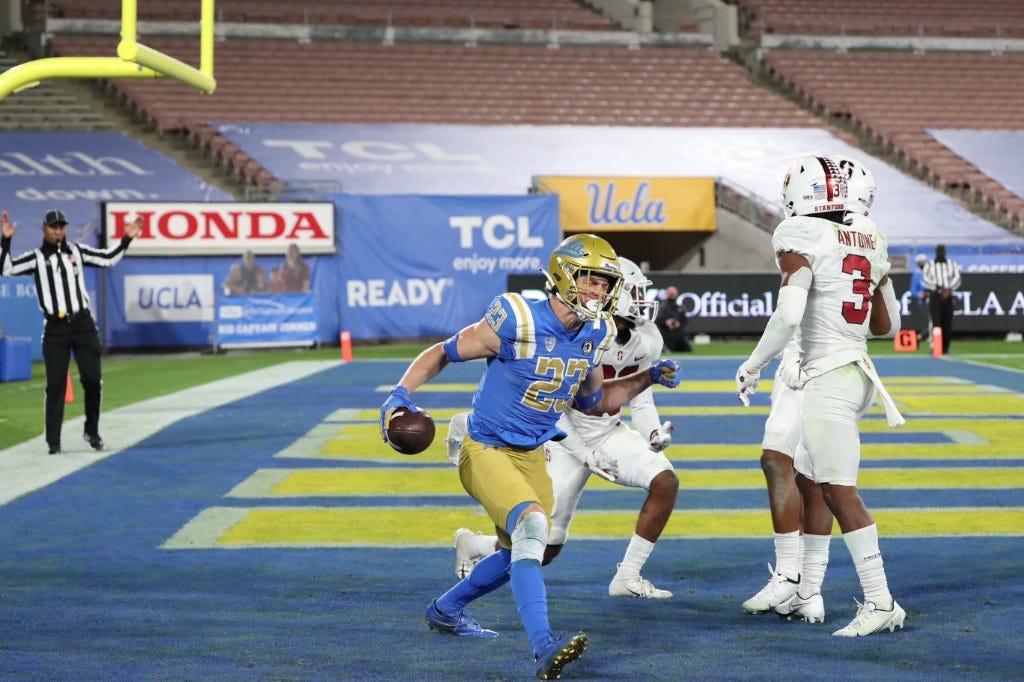UCLA Athletics Posts $62.5M Loss for 2021 Fiscal Year
The Athletic Department has now lost more than $100 million over three years.

After incurring a budget deficit totaling $40.6 million in 2019 and 2020, UCLA’s budget deficit blew up in the 2021 fiscal year to $62.5 million, according to a report this morning by respected Pac-12 columnist Jon Wilner. That brings the three year shortfall to more than $100 million.
When fans were not able to attend games during the 2020-2021 school year, a bigger deficit was certainly expected, but I’m not sure anyone could have fathomed that it would be quite this big.
Wilner’s article cites four reasons which “pummeled Pac-12 athletic departments” in 2021:
— Negligible ticket revenue because fans were not allowed to attend football and basketball games.
— Greatly reduced media revenue because the conference only played half the football season.
— Depressed philanthropic support and reduced sponsorship revenue.
— Reductions in travel and recruiting expenses were offset by the cost of COVID testing. (UCLA spent $2 million directly on COVID testing and another $1 million on shared conference costs.)
By comparison, UC Berkeley actually finished the year with a small surplus of $3.5 million. That’s a remarkable feat when considering all of the factors listed above.
Elsewhere in the Pac-12, Colorado finished the year with a $17.5 million loss while Utah’s budget deficit was $31 million.
Wilner also points out that Utah and other schools used furloughs as a way to help control expenses. UCLA did not require furloughs.
He also discusses the differences in the way the Berkeley and Los Angeles campuses treat athletics. He quotes Berkeley chancellor Carol Christ’s commitment which was made a few years ago to the athletic department. Christ wrote at the time, “I believe that our Intercollegiate Athletics program has great value for the Berkeley campus.”
Meanwhile, it appears that Gene Block continues to fail to understand the value that the athletic department brings as the de facto marketing arm of the university.
UC Berkeley covered $20.1 million in athletic department expenses while UCLA’s campus support topped out at just $2.5 million.
To be sure, $18 million or so in additional campus support would not have resulted in the department going from the red to the black, but it certainly would have helped in each of the past three years. In fact, it would have almost eliminated the deficit in 2019 and 2020 while cutting the 2021 deficit by about a third.
Instead, Block gave the department an interest-bearing loan in 2019 and 2020. Wilner’s article does not indicate if one was also provided in 2021, but it’s probably safe to assume that was the case, given that the money needed to come from somewhere.
I’ve noted before how the athletic department actually has to pay the university to use Pauley Pavilion because the building belongs to UCLA Recreation. Wilner is quick to point out how bizarre that situation is considering the fact that it was the athletic department, not UCLA Recreation which paid for the Pauley renovation.
With this information now available, it becomes much clearer as to why the department was not in a hurry to pay out a $9 million buyout to Chip Kelly, or the $4.6 million the department would have had to shell out for Kelly’s 2022 salary after his buyout expired earlier this month.
Go Bruins.
Thanks again for supporting The Mighty Bruin. Your paid subscriptions make this site possible. Questions, comments, story ideas, angry missives and more can be sent to to @TheMightyBruin on Twitter.


As long as Block is Chancellor I doubt anything will change as far as institutional support. Sadly. UCLA Athletics has a rich and compelling history. I hate to see it sullied by this.
In general- sports aren’t for the most part profitable enterprises. There was an article written a couple of years back regarding the profitability of La Liga (the Spanish Professional Soccer league) and out of the 20 teams only 3 are profitable, but none are serious about winning trophies. They just cash in on any assets they have and turn it into profit, whether that is a player contract being sold for big gains to bigger clubs, or having marketing campaigns (Middle East or China) where they can get twice the money in marketing contracts compared to what they would generate locally or in Europe.
All of this doesn’t surprise me at all, and my questions would be: 1. When was the last time UCLA Athletic Department profitable? 2. What was happening at that point on the field and on the court? (Considering that men’s football & basketball are the only two really profitable “sports products” a university really has) 3. How do Alabama, Ohio State, Michigan, Cincinnati Athletic Department fare off compared to UCLA’s considering that these 4 programs have done a great job this season in football (which is the biggest revenue setter for a university) in terms of their finances?
To cut it short, I play on a highly competitive amateur soccer league, the coach and a few other people (none players) pay for the team’s season registration which is about 500$ and the weekly cost of 120$ to “pay the ref.” There’s are 12 to 14 teams in the league on average every season. Each team plays twice, plus if you make it to the playoffs then add another 4 games more. The 1st place winner of the league gets 5K in prize money, 2nd place 3K. In essence, only those two teams can be “profitable” the rest are always going to be in the red.
I don’t know the intricacies of how a collegiate athletic department work, but from what little knowledge I have, it is obvious that there are serious issues in what’s being invested and what’s being returned on investment.